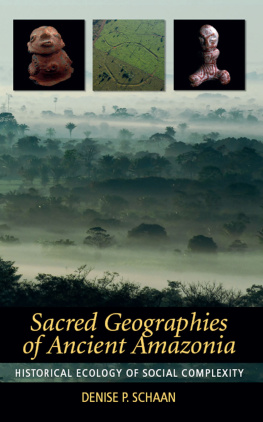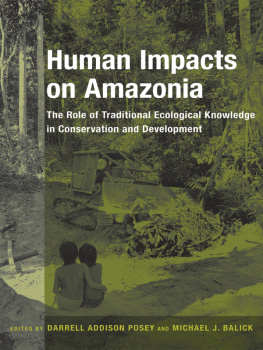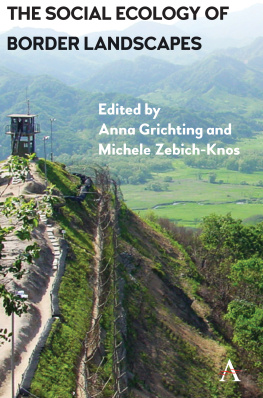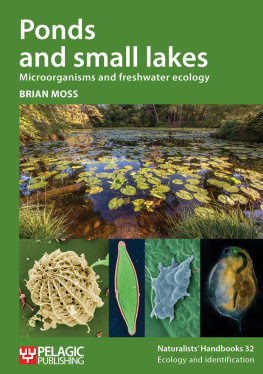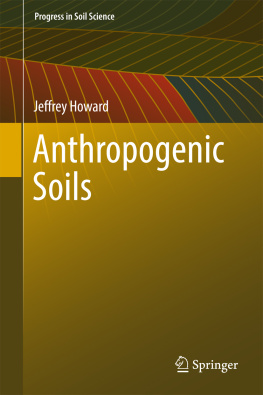
SACRED GEOGRAPHIES OF ANCIENT AMAZONIA
NEW FRONTIERS IN HISTORICAL ECOLOGY
Dynamic new research in the genuinely interdisciplinary field of historical ecology is flourishing in restoration and landscape ecology, geography, forestry and range management, park design, biology, cultural anthropology, and anthropological archaeology. Historical ecology corrects the flaws of previous ecosystems and disequilibrium paradigms by constructing transdisciplinary histories of landscapes and regions that recognize the significance of human activity and the power of all forms of knowledge. The preferred theoretical approach of younger scholars in many social and natural science disciplines, historical ecology is also being put into practice around the world by such organizations as the UNESCO. The series fosters the next generation of scholars offering a sophisticated grasp of human-environmental interrelationships. The series editors invite proposals for cutting edge books that break new ground in theory or in the practical application of the historical ecology paradigm to contemporary problems.
General Editors
William Bale, Tulane University
Carole L. Crumley, University of North Carolina, Chapel Hill
Editorial Advisory Board
Wendy Ashmore, University of California, Riverside
Peter Brosius, University of Georgia
Lyle Campbell, University of Utah
Philippe Descola, Collge de France
Dave Egan, Northern Arizona University
Rebecca Hardin, University of Michigan
Edvard Hviding, University of Bergen
William Marquardt, University of Florida
Kenneth R. Olwig, Swedish University of Agricultural Sciences
Gustavo Politis, Universidad de la Plata
Nathan Sayre, University of California, Berkeley
Stephan Schwartzman, Environmental Defense Fund
Series Titles
Vol. 1: Social and Ecological History of the Pyrenees: State, Market, and Landscape, Ismael Vaccaro and Oriol Beltran, eds.
Vol. 2: The Ten-Thousand Year Fever: Rethinking Human and Wild Primate Malarias, Loretta A. Cormier
Vol. 3: Sacred Geographies of Ancient Amazonia: Historical Ecology of Social Complexity, Denise P. Schaan
SACRED GEOGRAPHIES OF ANCIENT AMAZONIA
Historical Ecology of Social Complexity
Denise P. Schaan

First published 2012 by Left Coast Press, Inc.
Published 2016 by Routledge
2 Park Square, Milton Park, Abingdon, Oxon OX14 4RN
711 Third Avenue, New York, NY 10017, USA
Routledge is an imprint of the Taylor & Francis Group, an informa business
Copyright 2012 Taylor & Francis
All rights reserved. No part of this book may be reprinted or reproduced or utilised in any form or by any electronic, mechanical, or other means, now known or hereafter invented, including photocopying and recording, or in any information storage or retrieval system, without permission in writing from the publishers.
Notice:
Product or corporate names may be trademarks or registered trademarks, and are used only for identification and explanation without intent to infringe.
Library of Congress Cataloging-in-Publication Data:
Schaan, Denise Pahl, 1962
sacred geographies of ancient Amazonia : historical ecology of social complexity / Denise P. Schaan.
p. cm. (New frontiers in historical ecology; vol. 3)
Includes bibliographical references and index.
ISBN 978-1-59874-505-4 (hardcover : alk. paper) ISBN 978-1-61132-799-1 (ebook)
1. Indians of south americaamazon River Regionantiquities. 2. Indigenous peoplesEcologyamazon river region. 3. Human geographyamazon River Region. 4. social archaeologyamazon River region. 5. Indian potteryamazon river region. 6. Petrolgyphsamazon river region. 7. rock paintingsamazon river region. 8. amazon river regionantiquities. I. Title.
F2519.1.A6S243 2011
981'.1dc23
2011021600
Cover design by Jane Burton
ISBN 978-1-59874-505-4 hardcover
CONTENTS
A RCHAEOLOGY, AS HISTORY, offers a long-term perspective on society and culture. However, archaeology is the only discipline capable of recording the history of the societies that populated the pre-Columbian Americas during the several millennia that preceded the European conquest of the continent; with the exception of the Mayan Chilam Balam books, the original Americans did not leave any other written accounts.
This book is about the indigenous history of Amazoniaa history that has been written by archaeologists, geographers, ethnobotanists, soil scientists, ethnologists, and geologistsso it draws from diverse fields of inquiry and multiple lines of evidence. As I narrate this history I will define clearly both the information sources I used and the paths I followed to build up this complex, beautiful, and yet incomplete mosaic of life in the Amazonian tropical lowlands.
Human life in the moist South American tropics has been depicted frequently as a model of adaptation. The image of savage tribes of unclothed women, men, and children on the edge of starvation, surviving in the mysterious and dangerous jungle that covers a significant portion of most northern South American countries, is still part of the western imagination. This picture has been formed by more than 400 years of confrontations between indigenous societies and intruders into their lands. This image, however, is flawed, as it does not take into consideration the history of the resistance and the struggle of native peoples to maintain their cultures and defend their territories (Hemming 1978). It does not portray a way of life that is a culmination of a profound knowledge of plant and animal dynamics, crop domestication, hydraulic management, soil mulching, earth moving, the invention of ceramics, and other achievements that I will describe throughout the following chapters. A new approach is in order, one that rescues the natives point of view.
The historical ecology perspective allows for a portrait of indigenous history that is both fair and in line with the available scientific evidence (Bale 1998, 2006; Crumley 1994). Historical ecology takes into account the historicity of living places, not decoupling the environment from the people who live and have lived in it, but looking at society and the environment through a dialectic perspective. Indeed, it might sound obvious to say that people transform their surroundings, taking advantage of natural resources to satisfy their more diverse needs for food, shelter, and leisure. We know now from firsthand experience that overexploitation of the environment takes its toll, resulting in polluted waters, smoky air, and infertile soils, not to mention climate change and related environmental problems. The extent of human interaction with the environment in pre-Columbian times is less clear, however, and many of us still cling to an image of naked savages living in an immemorial, timeless Eden.
We know that our species, Homo sapiens, differs from other primates predominantly in our ability to create cultureas symbolic actionand transform our surroundings; why then do we deny the first peoples of Amazonia the same credit? This just does not make sense. To different degrees, and with different consequences, all human beings transform their surroundings (Bale 2006; Redman 1999; Sauer 1969) in their struggle to build a lifesupposedly betterfor themselves and their offspring. This does not happen as a single episode, but over many generations of accumulated know-how on managing landscapes.
Next page
